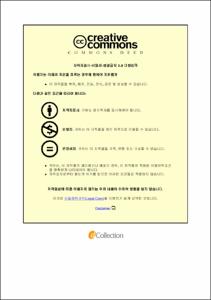한국과 중국 문화무역의 국제경쟁력 및 영향요인 비교연구
- Alternative Title
- A Comparative Study on Cultural Trade International Competitiveness and Influential Factors of Korea and China
- Abstract
- Cultural industry, known as the sunrise industry in the 21st century, has gradually become an important way to enhance the soft power of national culture. The great achievements of Korean cultural trade are closely related to its policy of "building a country by culture". The rise of Korean cultural industry has not only promoted the development of national economy, but also successfully shaped the national image. With the rapid economic development in recent years, China's cultural trade has made great progress, but compared with developed countries, its competitiveness is still very weak. Therefore, comparing and analyzing the development of cultural trade between Korea and China, finding out the gap and analyzing the reasons for the gap have realistic guiding significance for the healthy development of cultural trade between Korea and China.
This paper takes the cultural trade between Korea and China as the research object, and mainly studies the following problems:
1) How is the current development status of cultural trade between Korea and China?
2) How is the international competitiveness of cultural trade between Korea and China?
3) What are the factors that lead to the differences in cultural trade development and the level of international competitiveness between Korea and China?
Focusing on these research issues, this paper adopts a combination of qualitative and quantitative research methods. Firstly, it compares and analyzes the development status of cultural trade between Korea and China from the aspects of import and export scale of cultural trade and trade status of various industries. Secondly, using International Market Share, Trade Competition Index, Revealed Comparative Advantage Index, this paper calculates and compares the international competitiveness of cultural trade between the two countries. Thirdly, using Michael Porter Diamon Model, this paper qualitatively analyzes the reasons that lead to the differences in cultural trade development level and international competitiveness between the two countries from six aspects: production factor conditions, demand conditions, related and supporting industries, enterprise strategies, government policies and opportunities.
Finally, the following conclusions are drawn: First, Korean cultural trade is mainly based on the export of capital and talent-intensive high-tech cultural services, and its international competitiveness in personal cultural entertainment services is obviously superior to that of China. Second, China's cultural trade is mainly based on the export of labor-intensive and resource-intensive cultural products. Its core cultural products have strong international competitiveness. However, its cultural service trade is seriously lacking in international competitiveness. Third, the main reason for the above differences is the joint action of factors of production, demand conditions, related and supporting industries, enterprise strategies, government policies and opportunities. Korea's cultural industry is leaded by goverment policy, while China's cultural industry is still in the primary stage of "production factor-oriented".
Keywords: Cultural Trade, Cultural Industry, International Competitiveness.
- Issued Date
- 2021
- Awarded Date
- 2021. 2
- Type
- Dissertation
- Publisher
- 부경대학교
- Alternative Author(s)
- GUO JUAN
- Affiliation
- 부경대학교 대학원
- Department
- 대학원 경제학과
- Advisor
- 서석흥
- Table Of Contents
- Ⅰ. 서론 1
1. 연구의 배경 1
2. 연구의 필요성과 목적 2
3. 기존연구의 검토 3
1) 한중 문화무역의 발전현황에 관한 연구 3
2) 한중 문화무역의 국제경쟁력에 관한 연구 5
3) 문화무역의 영향요인에 관한 연구 5
4. 연구방법 및 논문의 구성 6
1) 연구방법 6
2) 논문의 구성 9
Ⅱ. 문화무역의 개념과 한중 문화무역의 발전현황 11
1. 문화무역의 개념 11
1) 문화산업의 정의와 범위 11
2) 문화무역의 정의와 분류 12
2. 한국 문화무역의 발전현황 13
1) 수출입규모 13
2) 업종별 무역현황 14
3. 중국 문화무역의 발전현황 20
1) 수출입규모 20
2) 업종별 무역현황 24
4. 한중 문화무역의 발전현황 평가 30
1) 수출입규모 평가 30
2) 업종별 무역현황 평가 31
Ⅲ. 한중 문화무역의 국제경쟁력 비교분석 32
1. 국제시장점유율 비교 32
1) 한중 문화상품의 국제시장점유율 비교 33
2) 한중 문화서비스의 국제시장점유율 비교 34
2. 무역경쟁력지수 비교 35
1) 한중 문화상품의 무역경쟁력지수 비교 36
2) 한중 문화서비스의 무역경쟁력지수 비교 37
3. 현시비교우위지수 비교 38
1) 한중 문화상품의 현시비교우위지수 비교 38
2) 한중 문화서비스의 현시비교우위지수 비교 39
4. 소결 40
Ⅳ. 한중 문화무역의 경쟁력 영향요인 비교분석--마이클 포터의 다이아몬드 모형을 중심으로 43
1. 생산요소조건 비교 46
1) 한국의 생산요소조건 46
2) 중국의 생산요소조건 47
3) 비교분석 및 문화무역의 국제경쟁력에 미치는 영향 49
2. 수요조건 비교 51
1) 한국의 수요조건 51
2) 중국의 수요조건 52
3) 비교분석 및 문화무역의 국제경쟁력에 미치는 영향 52
3. 관련 및 지원산업 비교 54
1) 한국의 관련 및 지원산업 54
2) 중국의 관련 및 지원산업 55
3) 비교분석 및 문화무역의 국제경쟁력에 미치는 영향 56
4. 기업전략 비교 57
1) 한국의 기업전략 57
2) 중국의 기업전략 58
3) 비교분석 및 문화무역의 국제경쟁력에 미치는 영향 59
5. 정부정책 비교 60
1) 한국의 정부정책 60
2) 중국의 정부정책 62
3) 비교분석 및 문화무역의 국제경쟁력에 미치는 영향 64
6. 기회 비교 66
1) 한국의 기회 66
2) 중국의 기회 67
3) 비교분석 및 문화무역의 국제경쟁력에 미치는 영향 67
7. 소결 68
1) 한국의 경우 69
2) 중국의 경우 70
Ⅴ. 결론 72
1. 요약 72
2. 시사점과 전망 74
참고문헌 77
- Degree
- Master
- Files in This Item:
-
-
Download
 한국과 중국 문화무역의 국제경쟁력 및 영향요인 비교연구.pdf
기타 데이터 / 1.07 MB / Adobe PDF
한국과 중국 문화무역의 국제경쟁력 및 영향요인 비교연구.pdf
기타 데이터 / 1.07 MB / Adobe PDF
-
Items in Repository are protected by copyright, with all rights reserved, unless otherwise indicated.